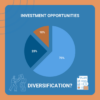What is a Target-Date Fund? According to investopedia.com target-date funds are mutual funds or exchange-traded funds (ETFs) structured to grow assets in a way that is optimized for a specific time frame. The structuring of these funds addresses an investor’s capital needs at some future date—hence, the name “target date.” Most often, investors will use a target-date fund to apply to their onset of retirement.
Target-Date Funds have grown dramatically over the last few decades. They are intended to be the solution for those that want to abdicate their investment decision responsibility. The plan sponsor also reduces fiduciary responsibility by providing a default option for the employee. The concept sounds reasonable. The typical young investor (30 years old) will have a target date 35 years out. That individual is assumed to have a high-risk tolerance with many years ahead to earn the higher average risk premium in stocks. Such a fund will begin heavily over weighted in stocks and systematically reduce the stock weight over time into bonds and cash. So, what are the problems?
Expenses:
- Look out for high expense ratios.
- Look out for double dipping. Target date fund expense ratio and the expense ratio of the underlying funds they invest in.
- Percent in cash: you are paying high expenses on a component that you can do yourself at no cost. This gets systematically worse as you move along toward the target date.
- Note difference between “to” and “through” the target date. “To” is to cash out at the target date and “through” is to continue into retirement. The latter maintains more equities in the portfolio.
- Limited investment choices by your plan sponsor (typically a single company). Denying you the opportunity to shop for a lower fee target date fund provider or better investment performing fund alternatives outside the fund family.
- The portfolio manager might take too much or too little risk as your proxy, including market-timing decisions. Furthermore, the manager’s incentives may not coincide with yours.
- The manager is unaware of the correlation of your other investments outside the target date fund.
Example 1: Vanguard Target Retirement fund 2025 (VTTVX) invests in four of its own index funds that cover the Total U.S. Stock Market, Total International Stock Market, Total US Bond Market and Total International Bond Market. The expense ratio is 0.15% and the Morningstar ranking is four stars. Morningstar looks into the composition of these sub portfolios and reports the following asset allocation for the entire target fund.

Example 2: The Putnam RetirementReady 2025 A (PRROX) indicates on its website that it holds six of its actively managed funds and its money market fund. The expense ratio is 0.98% and the Morningstar ranking is two stars. Morningstar reports its overall asset allocation as:

While the Putnam website indicates 4.81% in the money market fund, cash held in the other six funds brings the total to 20.98%. Since the fund expense ratio is 0.98% and cash earns near zero at this time, means investors are guaranteed to lose about 1% on 21% of this target fund. There is also substantial managerial risk in the remaining actively managed stock and bond strategies.
Example 3: The PIMCO RealPath 2025 Fund class C (PENWX) indicates on its website that the sub-indexes represent stocks, bonds, TIPs, commodities and real estate securities. The expense ratio is 1.87% and the Morningstar ranking is one star. Morningstar reports its overall asset allocation as:

Note the large % Short and % Long positions in Cash and Bonds. That means a lot of leverage is being employed. Leverage is effectively borrowing money to invest in more assets than the fund has capital. The sum of the long position percentages is 291.06%. That means a $100 million-dollar fund is purchasing the equivalent of $291.06 million in assets with an additional $191.06 million in borrowed funds or the equivalent exposure with derivatives. This fund as well as the other examples above were chosen to have the same nine years to the target retirement date. This is when risk is supposed to be winding down. Although leveraging very low risk assets might seem okay relative to no leverage on a high-risk asset, leverage has a potential large downside in a liquidity crisis (i.e., forced selling to meet margin calls). This happened big time in the Fall of 2008.
Besides the risk of managing the leverage within the fund, you want to know how this leverage affects your overall personal wealth portfolio’s leverage. Whether the leverage is obtained through direct borrowing or derivatives, it is effectively a short bond position. You need to know the maturity and duration (bond risk measure of its sensitivity to interest rate changes) of the position. Adding up all the long and short positions across all your investments is the only way to measure your total wealth portfolio net exposure. The process of aggregation applies to all the risk dimensions of your wealth portfolio. For example, the overall percentage of cash you hold will be decreased by the short (borrowing) positions and will be increased by the long (buy) positions in the mutual funds or Exchange Traded Funds (ETFs) you own. Similarly, the interest rate sensitivity of your longer-term bond investments is being reduced by your 30-year fixed rate mortgage (borrowing) on your home. Keeping track of all this information seems daunting, but modern technology can do all this for you in the background.
The important point of the three examples above is to show that all target funds are not alike. They each have their own costs and investment risks that are not likely to fit your unique personal goals. The only time I was forced to recommend including a target fund in a family member’s 401K was to allocate 100% of that 401K to the Vanguard Target Retirement 2050 Fund. All other funds available to him in the plan were poor choices (high expense ratios, active management with weak performance and elusive risk exposures). Being young, the cash allocation in Vanguard’s 2050 is small; it’s composed of all index funds and has a low expense ratio without double dipping. Furthermore, it was a small part of his wealth relative to his taxable account where all the remaining or offsetting exposures can be obtained in other accounts. This individual will rollover that 401K to an IRA when next changing jobs and then have complete control to achieve a superior portfolio strategy.
Good News: You don’t need target date funds to achieve a dynamic time dependent risk strategy. You can create your own target date wealth strategy with full knowledge of all the assets you own at a lower cost. And ever better, there is a great solution for managing a holistic target date portfolio with Ripsaw Wealth Tools wealth management software. Try today!



